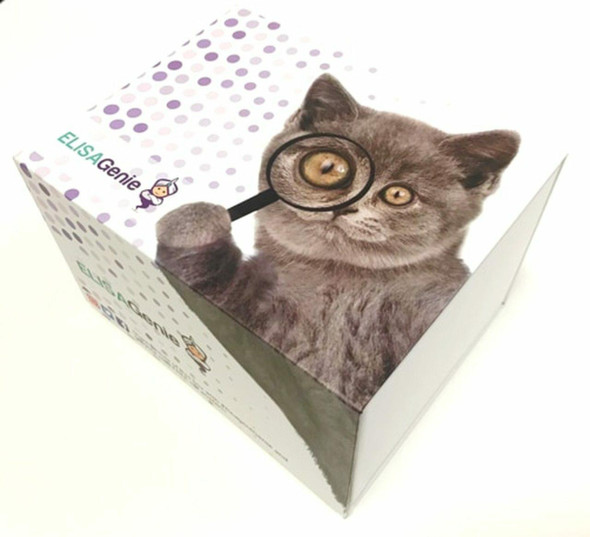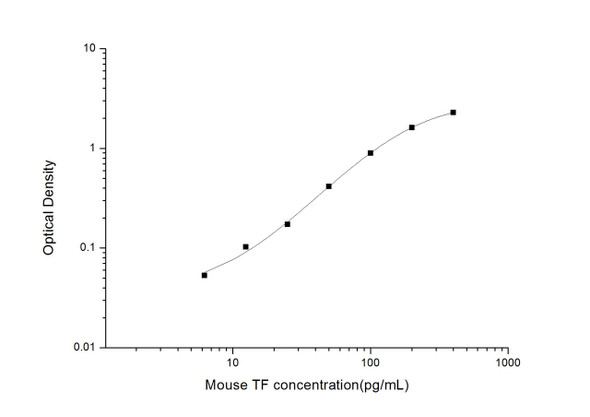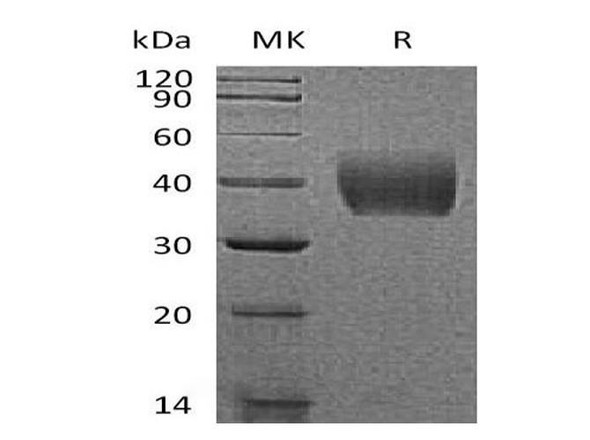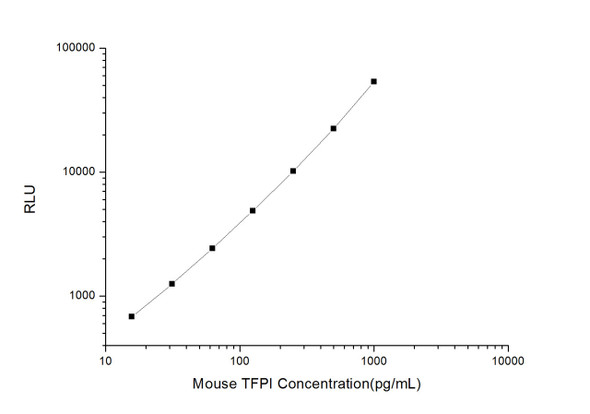Mouse Cardiovascular ELISA Kits
Mouse TF (Tissue factor) CLIA Kit (MOES00566)
- SKU:
- MOES00566
- Product Type:
- ELISA Kit
- ELISA Type:
- CLIA Kit
- Size:
- 96 Assays
- Sensitivity:
- 1.88pg/mL
- Range:
- 3.13-200pg/mL
- ELISA Type:
- Sandwich
- Synonyms:
- F3, FIII, CD142, TFA, Thromboplastin, Coagulation Factor III
- Reactivity:
- Mouse
- Sample Type:
- Serum, plasma and other biological fluids
- Research Area:
- Cardiovascular
Description
| Assay type: | Sandwich |
| Format: | 96T |
| Assay time: | 4.5h |
| Reactivity: | Mouse |
| Detection method: | Chemiluminescence |
| Detection range: | 3.13-200 pg/mL |
| Sensitivity: | 1.88 pg/mL |
| Sample volume: | 100µL |
| Sample type: | Serum, plasma and other biological fluids |
| Repeatability: | CV < 15% |
| Specificity: | This kit recognizes Mouse TF in samples. No significant cross-reactivity or interference between Mouse TF and analogues was observed. |
This kit uses Sandwich-CLIA as the method. The micro CLIA plate provided in this kit has been pre-coated with an antibody specific to Mouse TF. Standards or samples are added to the appropriate micro CLIA plate wells and combined with the specific antibody. Then a biotinylated detection antibody specific for Mouse TF and Avidin-Horseradish Peroxidase (HRP) conjugate are added to each micro plate well successively and incubated. Free components are washed away. The substrate solution is added to each well. Only those wells that contain Mouse TF, biotinylated detection antibody and Avidin-HRP conjugate will appear fluorescence. The Relative light unit (RLU) value is measured spectrophotometrically by the Chemiluminescence immunoassay analyzer. The RLU value is positively associated with the concentration of Mouse TF. The concentration of Mouse TF in the samples can be calculated by comparing the RLU of the samples to the standard curve.
| UniProt Protein Function: | F3: Initiates blood coagulation by forming a complex with circulating factor VII or VIIa. The [TF:VIIa] complex activates factors IX or X by specific limited protolysis. TF plays a role in normal hemostasis by initiating the cell-surface assembly and propagation of the coagulation protease cascade. Interacts with HSPE; the interaction, inhibited by heparin, promotes the generation of activated factor X and activates coagulation in the presence of activated factor VII. TF expression is highly dependent upon cell type. TF can also be induced by the inflammatory mediators interleukin 1 and TNF-alpha, as well as by endotoxin, to appear on monocytes and vascular endothelial cells as a component of cellular immune response. Lung, placenta and pancreas. Belongs to the tissue factor family. 2 isoforms of the human protein are produced by alternative splicing. |
| UniProt Protein Details: | Protein type:Cell surface; Membrane protein, integral Cellular Component: cell surface; cytoplasm; extracellular matrix; extracellular space; integral to membrane; membrane; plasma membrane Molecular Function:hematopoietin/interferon-class (D200-domain) cytokine receptor activity; phospholipid binding; protease binding Biological Process: activation of plasma proteins during acute inflammatory response; blood coagulation; caspase activation; cytokine and chemokine mediated signaling pathway; hemostasis; positive regulation of angiogenesis; positive regulation of endothelial cell proliferation; positive regulation of protein kinase B signaling cascade; positive regulation of smooth muscle cell migration |
| NCBI Summary: | This gene encodes a membrane-bound glycoprotein that forms the primary physiological initiator of the blood coagulation process following vascular damage. The encoded protein binds to coagulation factor VIIa and the ensuing complex catalyzes the proteolytic activation of coagulation factors IX and X. Mice lacking encoded protein die in utero resulting from massive hemorrhaging in both extraembryonic and embryonic vessels. A severe deficiency of the encoded protein in mice results in impaired uterine homeostasis, shorter life spans due to spontaneous fatal hemorrhages and cardiac fibrosis. [provided by RefSeq, Aug 2015] |
| UniProt Code: | P20352 |
| NCBI GenInfo Identifier: | 135667 |
| NCBI Gene ID: | 14066 |
| NCBI Accession: | P20352. 2 |
| UniProt Related Accession: | P20352 |
| Molecular Weight: | 32,935 Da |
| NCBI Full Name: | Tissue factor |
| NCBI Synonym Full Names: | coagulation factor III |
| NCBI Official Symbol: | F3 |
| NCBI Official Synonym Symbols: | TF; Cf3; Cf-3; CD142; AA409063 |
| NCBI Protein Information: | tissue factor |
| UniProt Protein Name: | Tissue factor |
| UniProt Synonym Protein Names: | Coagulation factor III; CD_antigen: CD142 |
| Protein Family: | Tissue factor |
| UniProt Gene Name: | F3 |
| UniProt Entry Name: | TF_MOUSE |
As the RLU values of the standard curve may vary according to the conditions of the actual assay performance (e. g. operator, pipetting technique, washing technique or temperature effects), the operator should establish a standard curve for each test. Typical standard curve and data is provided below for reference only.
| Concentration (pg/mL) | RLU | Average | Corrected |
| 200 | 39668 48478 | 44073 | 44035 |
| 100 | 16735 19687 | 18211 | 18173 |
| 50 | 8328 8084 | 8206 | 8168 |
| 25 | 3689 4181 | 3935 | 3897 |
| 12.5 | 1993 1971 | 1982 | 1944 |
| 6.25 | 1107 997 | 1052 | 1014 |
| 3.13 | 591 605 | 598 | 560 |
| 0 | 38 38 | 38 | -- |
Precision
Intra-assay Precision (Precision within an assay): 3 samples with low, mid range and high level Mouse TF were tested 20 times on one plate, respectively.
Inter-assay Precision (Precision between assays): 3 samples with low, mid range and high level Mouse TF were tested on 3 different plates, 20 replicates in each plate.
| Intra-assay Precision | Inter-assay Precision | |||||
| Sample | 1 | 2 | 3 | 1 | 2 | 3 |
| n | 20 | 20 | 20 | 20 | 20 | 20 |
| Mean (pg/mL) | 9.98 | 19.94 | 79.55 | 9.22 | 19.52 | 86.84 |
| Standard deviation | 1.10 | 2.01 | 6.35 | 1.01 | 2.24 | 6.16 |
| C V (%) | 11.02 | 10.08 | 7.98 | 10.95 | 11.48 | 7.09 |
Recovery
The recovery of Mouse TF spiked at three different levels in samples throughout the range of the assay was evaluated in various matrices.
| Sample Type | Range (%) | Average Recovery (%) |
| Serum (n=5) | 94-108 | 101 |
| EDTA plasma (n=5) | 101-116 | 107 |
| Cell culture media (n=5) | 94-110 | 102 |
Linearity
Samples were spiked with high concentrations of Mouse TF and diluted with Reference Standard & Sample Diluent to produce samples with values within the range of the assay.
| Serum (n=5) | EDTA plasma (n=5) | Cell culture media (n=5) | ||
| 1:2 | Range (%) | 94-109 | 88-104 | 96-110 |
| Average (%) | 102 | 95 | 101 | |
| 1:4 | Range (%) | 97-112 | 94-108 | 94-106 |
| Average (%) | 104 | 99 | 99 | |
| 1:8 | Range (%) | 85-100 | 88-104 | 91-103 |
| Average (%) | 91 | 96 | 97 | |
| 1:16 | Range (%) | 92-106 | 87-100 | 93-104 |
| Average (%) | 97 | 94 | 99 |
An unopened kit can be stored at 4°C for 1 month. If the kit is not used within 1 month, store the items separately according to the following conditions once the kit is received.
| Item | Specifications | Storage |
| Micro CLIA Plate(Dismountable) | 8 wells ×12 strips | -20°C, 6 months |
| Reference Standard | 2 vials | |
| Concentrated Biotinylated Detection Ab (100×) | 1 vial, 120 µL | |
| Concentrated HRP Conjugate (100×) | 1 vial, 120 µL | -20°C(shading light), 6 months |
| Reference Standard & Sample Diluent | 1 vial, 20 mL | 4°C, 6 months |
| Biotinylated Detection Ab Diluent | 1 vial, 14 mL | |
| HRP Conjugate Diluent | 1 vial, 14 mL | |
| Concentrated Wash Buffer (25×) | 1 vial, 30 mL | |
| Substrate Reagent A | 1 vial, 5 mL | 4°C (shading light) |
| Substrate Reagent B | 1 vial, 5 mL | 4°C (shading light) |
| Plate Sealer | 5 pieces | |
| Product Description | 1 copy | |
| Certificate of Analysis | 1 copy |
- Set standard, test sample and control (zero) wells on the pre-coated plate and record theirpositions. It is recommended to measure each standard and sample in duplicate. Note: addall solutions to the bottom of the plate wells while avoiding contact with the well walls. Ensuresolutions do not foam when adding to the wells.
- Aliquot 100µl of standard solutions into the standard wells.
- Add 100µl of Sample / Standard dilution buffer into the control (zero) well.
- Add 100µl of properly diluted sample (serum, plasma, tissue homogenates and otherbiological fluids. ) into test sample wells.
- Cover the plate with the sealer provided in the kit and incubate for 90 min at 37°C.
- Aspirate the liquid from each well, do not wash. Immediately add 100µL of BiotinylatedDetection Ab working solution to each well. Cover the plate with a plate seal and gently mix. Incubate for 1 hour at 37°C.
- Aspirate or decant the solution from the plate and add 350µL of wash buffer to each welland incubate for 1-2 minutes at room temperature. Aspirate the solution from each well andclap the plate on absorbent filter paper to dry. Repeat this process 3 times. Note: a microplatewasher can be used in this step and other wash steps.
- Add 100µL of HRP Conjugate working solution to each well. Cover with a plate seal andincubate for 30 min at 37°C.
- Aspirate or decant the solution from each well. Repeat the wash process for five times asconducted in step 7.
- Add 100µL of Substrate mixture solution to each well. Cover with a new plate seal andincubate for no more than 5 min at 37°C. Protect the plate from light.
- Determine the RLU value of each well immediately.






